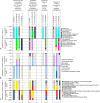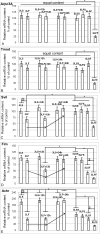The Development Of Drosophila Melanogaster under Different Duration Space Flight and Subsequent Adaptation to Earth Gravity
- PMID: 27861601
- PMCID: PMC5115863
- DOI: 10.1371/journal.pone.0166885
The Development Of Drosophila Melanogaster under Different Duration Space Flight and Subsequent Adaptation to Earth Gravity
Abstract
In prospective human exploration of outer space, the need to preserve a species over several generations under changed gravity conditions may arise. This paper demonstrates our results in the creation of the third generation of fruit fly Drosophila melanogaster (third-stage larvae) during the 44.5-day space flight (Foton-M4 satellite (2014, Russia)), then the fourth generation on Earth and the fifth generation again in conditions of the 12-day space flight (2014, in the Russian Segment of the ISS). The species preserves fertility despite a number of changes in the level of expression and content of cytoskeletal proteins, which are the key components of the cleavage spindle and the contractile ring of cells. The results of transcriptome screening and space analysis of cytoskeletal proteins show that the exposure to weightless conditions leads to the increased transcription of metabolic genes, cuticle components and the decreased transcription of genes involved in morphogenesis, cell differentiation, cytoskeletal organization and genes associated with the plasma membrane. "Subsequent" exposure to the microgravity for 12 days resulted in an even more significant increase/decrease in the transcription of the same genes. On the contrary, the transition from the microgravity conditions to the gravity of Earth leads to the increased transcription of genes whose products are involved in the morphogenesis, cytoskeletal organization, motility of cells and transcription regulation, and to the decreased transcription of cuticle genes and proteolytic processes.
Conflict of interest statement
The authors have declared that no competing interests exist.
Figures









Similar articles
-
[Development of Drosophila melanogaster in space flight].Aviakosm Ekolog Med. 2014;48(3):5-11. Aviakosm Ekolog Med. 2014. PMID: 25163332 Review. Russian.
-
Spaceflight-related suboptimal conditions can accentuate the altered gravity response of Drosophila transcriptome.Mol Ecol. 2010 Oct;19(19):4255-64. doi: 10.1111/j.1365-294X.2010.04795.x. Epub 2010 Aug 31. Mol Ecol. 2010. PMID: 20819157
-
Sperm of Fruit Fly Drosophila melanogaster under Space Flight.Int J Mol Sci. 2022 Jul 6;23(14):7498. doi: 10.3390/ijms23147498. Int J Mol Sci. 2022. PMID: 35886847 Free PMC article.
-
Drosophila melanogaster, a model system for comparative studies on the responses to real and simulated microgravity.J Gravit Physiol. 2007 Jul;14(1):P125-6. J Gravit Physiol. 2007. PMID: 18372731
-
Drosophila melanogaster and the future of 'evo-devo' biology in space. Challenges and problems in the path of an eventual colonization project outside the earth.Adv Space Biol Med. 2003;9:41-81. doi: 10.1016/s1569-2574(03)09003-8. Adv Space Biol Med. 2003. PMID: 14631629 Review.
Cited by
-
Space omics research in Europe: Contributions, geographical distribution and ESA member state funding schemes.iScience. 2022 Feb 15;25(3):103920. doi: 10.1016/j.isci.2022.103920. eCollection 2022 Mar 18. iScience. 2022. PMID: 35265808 Free PMC article. Review.
-
Single Cell in a Gravity Field.Life (Basel). 2022 Oct 14;12(10):1601. doi: 10.3390/life12101601. Life (Basel). 2022. PMID: 36295035 Free PMC article. Review.
-
Circadian regulation in aging: Implications for spaceflight and life on earth.Aging Cell. 2023 Sep;22(9):e13935. doi: 10.1111/acel.13935. Epub 2023 Jul 26. Aging Cell. 2023. PMID: 37493006 Free PMC article. Review.
-
Transcriptomic changes in an animal-bacterial symbiosis under modeled microgravity conditions.Sci Rep. 2017 Apr 10;7:46318. doi: 10.1038/srep46318. Sci Rep. 2017. PMID: 28393904 Free PMC article.
-
Asparagine biosynthesis as a mechanism of increased host lethality induced by Serratia marcescens in simulated microgravity environments.Heliyon. 2022 May 4;8(5):e09379. doi: 10.1016/j.heliyon.2022.e09379. eCollection 2022 May. Heliyon. 2022. PMID: 35592661 Free PMC article.
References
-
- Dubinin N, Vaulina E. The evolutionary role of gravity. Life Sci. Space Res. 1976; 14: 47–55. - PubMed
-
- Ross M. The influence of gravity on structure and function of animals. Adv. Space Res. 1984; 4: 305–314. - PubMed
-
- Tairbekov MG, Klimovitskii V, Oganov VS. The role of gravitational force in the evolution of living systems (the biomechanical and energy aspects). Izv. Akad. Nauk. Ser. Biol. 1997; 5: 517–530. - PubMed
-
- Claassen DE, Spooner BS. Impact of Altered Gravity on Aspects of Cell Biology. Int. Rev. Cytol. 1994; 156: 301–373. - PubMed
-
- Buravkova LB, Romanov YaA. The role of cytoskeleton in cell changes under condition of simulated microgravity. Acta Astronaut. 2001; 48: 5–12. - PubMed
MeSH terms
Substances
LinkOut - more resources
Full Text Sources
Other Literature Sources
Molecular Biology Databases

